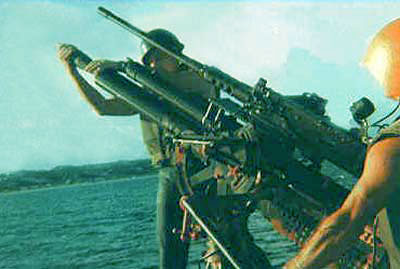
|
The United States Coast Guard's Piggyback 81mm Mortar / .50-cal Machine Gun By Chief Gunner's Mate William R. Wells II USCG
Vietnam Magazine August 1997 |

|
| Image courtesy of CSC Robert O. Burton, USCG (ret) |
One of the more innovative weapons used by many of the small combatant craft during the Vietnam conflict was developed by the USCG
just prior to the start of US involvement in South East Asia. It was the combination of trigger fired 81mm mortar and .50 caliber
machine gun installed not only on Coast Guard vessels, but also on the Navy's Swift Boats and Riverine Craft
|
|
|
Because of its multi-functional role, the U. S. Coast Guard has fostered innovation with-in its ranks throughout its long history.
Often forced to function with insufficient funding, the Coast Guard has always relied on the "can-do" motivation of its guardsmen to
complete the mission
With one of its primary roles being search and rescue at sea, the need for providing illumination for night time operations has always been a Coast Guard priority. |
Both during World War II and the years following, this capability was provided by flares fired from three inch and five inch guns installed on its sea going cutters and weather ships. However, this method often performed poorly. The light of the flares was either too bright or too low in height to be of much use to the rescuers on the ships. The black powder used for these rounds also quickly gummed the barrels of the guns, creating the need to clean them after only four to six flares had been fired. | 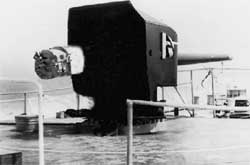 |
With these problems in mind, the Coast Guard began to look for a better at-sea illumination system late in 1962. The primary function of the new system would be to supplement the existing means, and give commanding officers of cutters greater latitude in establishing emergency illumination. The alternative was found in the U. S. Navy's 81mm mortar. |
The Office of Gunnery and Readiness at Coast Guard headquarters approved the installation of the 81mm mortars, and did not restrict their use only to ocean station vessels. With the relatively light weight of the mount (about 400 pounds) and the added possibility of firing explosive ordinance, it was conceived that this system might be adapted for use on the smaller 82-foot and 95-foot patrol boats, whose primary mission up to that time had been law enforcement. These boats were only equipped with the aging 20mm Oerlikon machine guns, which were useful for law enforcement, but provided no capability for the search and rescue missions which these craft were increasingly being tasked to with. Planners believed that the new weapon might possibly be modified to replace the out dated large machine guns on these patrol craft and therefore provide utility as both a weapon and an illumination system. |
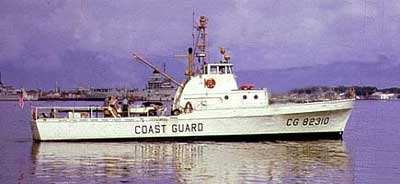
|
The project of adapting the mortar for dual purpose use was given to the only ordinance man assigned to Coast Guard headquarters,
Chief Warrant Officer (Guns) Elmer I. Hicks, a former fire control technician. By mid-1964, Hicks had come up with the idea to build
upon the trigger fire capability of the mortar and mount a .50 caliber machine gun over it. This would, in fact, then become a triple
use system: machine gun, illumination system, and short range naval "gun." This seemed likely to satisfy all of the requirements of the
patrol craft for law enforcement plus search and rescue operations.
Ordinance shop head Bob Penning, a single welder and one mechanist were assigned the task of interpreting Hicks' quick sketches of the
weapon at the Coast Guard Yard in Curris Bay, Maryland. Within a single eight hour workday, they had produced a design mockup of the
piggyback arrangement. Because all weapons of .50 caliber and above were owned by the Navy, Hicks had to request permission from the
Navy Bureau of Ordinance to adapt the mortar to dual purpose use. The Navy granted permission, and the Maryland Ordinance Shop produced
the first usable version two days later.
|
In late 1964, Hicks took his invention to the Dahlgren Proving Grounds for test firing from a flat bed truck. Following these successful land tests, two of the mounts were installed on board a 95-foot patrol boat at Norfolk, Virginia. Similar tests on this vessel in the waters off Hampton Roads quickly proved that the mortar and the machine gun combination was a viable one. |
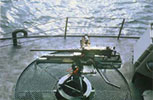
|
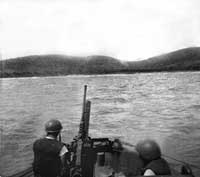 |
These tests also provided data showing that the added weight of the mortar enabled more accurate fire when using the machine gun. This despite the quick pitch and roll which was common on smaller patrol boats in anything other than calm waters. Later experience along the Vietnamese coast would prove out the accuracy of the piggyback machine gun in the prevalent sea conditions encountered there to be in excess of 1,000 yards. |
One improvement indicated from the tests was to add a counter weight spring to the mount to give the gunner better control of the combination during firing of the machine gun. There were two variations of the counter weight spring. The original was installed horizontally on the right side of the mount. A later version was mounted vertically on the left side of the mount. This second version made room for a 400 round ammunition box that was used by the Patrol Craft Fast (PCFs), or Swift Boats. |
In keeping with the primary function of the mortar to provide illumination, Hicks also, with the help of the ordinance shop, manufactured a timing fuse setter for the standard 81mm illumination round. Prior to this added capability, one crewman had to hold the round and set the fuse timing while another focused a flashlight on the process. This procedure was too slow and inaccurate to be of much use in either combat or during the expediency of search and rescue operations. A small light was added to the fuse setter, eliminating the need for two crewmen to set the fuses. | 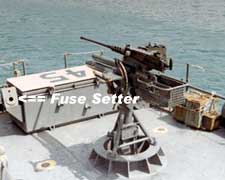 |
|
The Navy also used this concept on the Swift Boats, installing the setter on the side of the ready service locker.
As described elsewhere on this web site, in early 1965, the U. S. Navy discovered that it did not have the capability to patrol the shallow waters off the coast of Vietnam. Concentrating on its role of keeping the deep water sea lanes open, the Navy had virtually ignored the possibility that coastal warfare would be an integral part of its operations. With only the Seventh Fleet available to counter infiltration from North Vietnam, the Navy was at a major disadvantage in trying to prosecute shallow water junks transporting contraband material and personnel along the coast and into the rivers. |
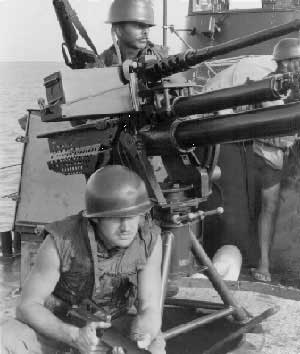 |
The Navy asked the Coast Guard to supply seventeen (17) of its Point Class 82-foot patrol boats for use in addressing this new threat. Initially, the Navy only requested the vessels, intending to use Navy personnel to crew them. But the Coast Guard, still less than pleased that it had been ignored during the Korean conflict, insisted that Coast Guardsmen man any of their assets used in this one. This stipulation turned out to be fortunate, because Coast Guard crews were available for immediate action, allowing the Navy time to develop and produce new craft, then train crews to operate them. During the first eighteen to twenty-four months of patrol craft deployment to Vietnam, the 82-foot cutters of the Coast Guard carried out the majority of the interdiction patrols along the coastline. |
Due to their lack of small craft expertise, the Navy deferred the decision on how to arm the patrol craft to the Coast Guard. Hicks' innovation gave the deployed vessels a 360 degree field of fire of both heavy machine gun rounds and mortar ordinance. He was instrumental in overseeing the construction of the first 200 combined or piggyback mounts for small craft deployed early in the war. At least one of Hick's initial production of mounts found its way to U. S. Army Special Forces who mounted it in a truck bed and used it with success in the delta areas of IV Corps. |
Two other modification / additions to the weapon were made subsequent to initial deployment to South East Asia, based on operational experience. Many of the Coast Guard gunner's mates added an extended handle along side the recoil basket to make it easier to control and aim the mortar when firing it in the trigger mode. They also cut out the bottom of the recoil basket protective guard to allow the expended .50 caliber casings to fall to the deck rather than filling up the basket and interfering with the recoil function. | 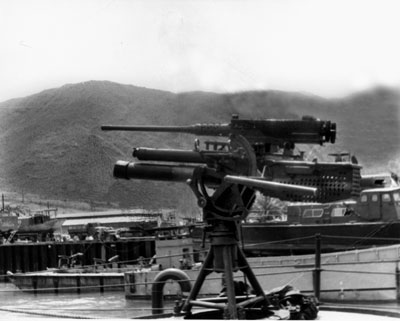 |
There did occur several unfortunate, and very tragic, misfire incidents associated with this weapon during its early deployment. But
these were, and still are, attributed to the ammunition used rather than any basic design flaws with the weapon itself.
Although initially deployed for use on Coast Guard cutters, the weapon became one of the most effective tools in the arsenals of many
craft used along the coasts and rivers of Vietnam. The successes that the combined force of Coast Guard, Navy and water borne Army
troops achieved in interdicting infiltrators and then pacifying the areas where they held responsibility, can be attributed, in part,
to the innovative thinking of Warrant Officer Hicks.
As developed and refined by the Coast Guard in the 1960's, the combined 81mm mortar/.50 caliber machine gun proved its
worth time and time again in the waters of South East Asia. It was one of the most rapidly developed and fielded weapons of the war.
Extensively and reliably used by the American military throughout the conflict
|
|
|
| Bill Wells served aboard USCG Cutters {WPBs} Point Dume, Point Glover and Point Kennedy in northern I Corps. |
|
For additional information on the 81mm Naval Mortar, visit the ordinance notes by Bob Stoner at Mk 2 Mod 0 and Mod 1 .50 Caliber MG/81mm Mortar |
This web site is Copyright � 2002 by Robert B. Shirley. All rights reserved. Click on image to return to the homepage
|